Biological
There are two methods
that the Vikings could have used to locate the
sun with a transparent, rhombohedral shaped
piece of Icelandic Spar. One of the methods
that was studied by several scientist of The
Royal Society in early 2012 used a biological
phenomenon. This involves a very small
sensitivity to polarized light in the fovea of
the human eye. They are still unsure of
exactly why this phenomenon occurs, but, as
the diagram depicts, one can find the location
of the sun using a calcite crystal. To do
this, the viewer simply holds the calcite up
to one eye while looking at a blue patch of
sky. Then they quickly remove the calcite and
a yellow pattern can be seen imprinted in
their field of vision for a split second.
Following the axis of this pattern, the sun's
general direction can be found. Were the
Vikings clever enough to discover and utilize
this elusive phenomenon? Or did they use a
less complicated method? Before we explore
these questions, let's take a look at some of
the uses for Iceland Spar.

